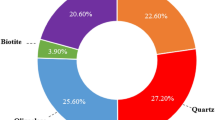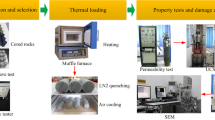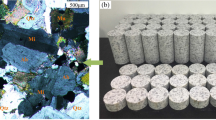Abstract
Hot dry rock (HDR) contains abundant thermal energy, which can be extracted through fracturing and used for electricity generation. Due to its deep depth, high-temperature and high-pressure conditions, it is difficult to initiate fractures for conventional hydraulic fracturing technology. This paper study the advantage of cryogenic fracturing on the HDR. We conducted a series of laboratory experiments on rock samples with different length of open-hole under triaxial-confining stresses (10 MPa). The nitrogen fracturing wellbores of high temperature (100–300 ℃) granites were treated with LN (liquid nitrogen) and NO-LN and retained with 20 mm and 30 mm open-hole to form four control groups. The fracturing results show that LN cryogenic stimulation is more effective in reducing the HDR initiation pressure. When the open-hole is 20 mm, the breakdown pressure of samples with LN decreases by 13.9%–18.7% compared with untreated samples. When the open-hole changed from 20 mm to 30 mm, the breakdown pressure of samples with NO-LN are reduced by 6.7%–15%. The samples with a 30 mm open-hole inside the wellbore formed complex fracture patterns after the nitrogen fracturing. This could be attributed to the longer open-hole, the more complex micro-fractures on the surface and the force of the direction parallel to the cross section is significantly increased.
Copyright 2023, IFEDC Organizing Committee.
This paper was prepared for presentation at the 2023 International Field Exploration and Development Conference in Wuhan, China, 20–22 September 2023.
This paper was selected for presentation by the IFEDC Committee following review of information contained in an abstract submitted by the author(s). Contents of the paper, as presented, have not been reviewed by the IFEDC Technical Team and are subject to correction by the author(s). The material does not necessarily reflect any position of the IFEDC Technical Committee its members. Papers presented at the Conference are subject to publication review by Professional Team of IFEDC Technical Committee. Electronic reproduction, distribution, or storage of any part of this paper for commercial purposes without the written consent of IFEDC Organizing Committee is prohibited. Permission to reproduce in print is restricted to an abstract of not more than 300 words; illustrations may not be copied. The abstract must contain conspicuous acknowledgment of IFEDC. Contact email: paper@ifedc.org.
Access this chapter
Tax calculation will be finalised at checkout
Purchases are for personal use only
Similar content being viewed by others
References
Breede, K., Dzebisashvili, K., Liu, X., et al.: A systematic review of enhanced (or engineered) geothermal systems: past, present and future. J. Geotherm Energy 1, 4 (2013)
Cha, M., Alqahtani, N.B., Yin, X., et al.: Laboratory system for studying cryogenic thermal rock fracturing for well stimulation. J. Pet. Sci. Eng. 156, 780–789 (2017)
Cha, M., Alqahtani, N.B., Yao, B., et al.: Cryogenic fracturing of wellbores under true triaxial-confining stresses: experimental investigation. SPE J. Preprint. SPE-180071-PA (2018)
Hu, L., Ghassemi, A., Pritchett, J., et al.: Experimental simulation of enhanced geothermal reservoir stimulation. In: Proceedings: Geothermal Resources Council Annual Meeting. Sacramento, CA (2016)
Legarth, B., Huenges, E., Zimmermann, G.: Hydraulic fracturing in a sedimentary geothermal reservoir: results and implications. J. Int. J. Rock Mech. Min. Sci. 42(7–8), 1028–1041 (2005)
McDaniel, B., Grundmann, S., Kendrick, W., et al.: Field applications of cryogenic nitrogen as a hydraulic fracturing fluid. In: Proceedings: the SPE Annual Technical Conference and Exhibition. San Antonio, Texas (1997)
Nicot, J.-P., Scanlon, B.R.: Water use for shale-gas production in Texas US. Environ. Sci. Technol. 46(6), 3580–3586 (2012)
Rassenfoss, S.: In search of the waterless fracture. J. Petrol. Technol. 65(06), 46–54 (2013)
Riahi, A., Damjanac, B., Furtney, J.: Stimulation and heat production of EGS reservoirs. ARMA 14-7741 (2014)
Wang, H., Lu, Q., Li, X., et al.: Design of experimental system for supercritical CO2 fracturing under confining pressure conditions. J. Instrum. 13(03), P03017 (2018)
Yao, B., Wang, L., Patterson, T., et al.: Experimental study and modeling of cryogenic fracturing treatment of synthetic rock samples using liquid nitrogen under tri-axial stresses. In: Proceedings: The SPE Unconventional Resources Conference, Calgary, Alberta, Canada (2017)
Yang, R., Huang, Z., Shi, Y., et al.: Laboratory investigation on cryogenic fracturing of hot dry rock under triaxial-confining stresses. J. Geothermics 79, 46–60 (2019)
Zheng, K., Chen, Z.: Hot dry rock development in china: a long way to go. J. Sino-Glob. Energy 22(02), 21–25 (2017)
Acknowledgements
This work was supported by the major project of the National Natural Science Foundation of China’s South China Sea gas hydrate drilling mechanism and control (No. 51991360) Gas hydrate drilling wellbore multiphase flow obstacle formation mechanism and safety control method (No. 51991363) and China National Petroleum Corporation Scientific Research and Technology Development Project “Formation Mechanism and Safety Control Method of Multiphase Flow Obstacle in Gas Hydrate Drilling Wellbore” (No. 2022DQ0524).
Author information
Authors and Affiliations
Corresponding author
Editor information
Editors and Affiliations
Rights and permissions
Copyright information
© 2024 The Author(s), under exclusive license to Springer Nature Singapore Pte Ltd.
About this paper
Cite this paper
Huang, Pp., Li, M., Hao, Ww., Wang, H., Li, Yf., Zou, Y. (2024). Laboratory Investigation of Cryogenic Fracturing Effect of Hot Dry Rock Wellbores Under Triaxial-Confining Stresses. In: Lin, J. (eds) Proceedings of the International Field Exploration and Development Conference 2023. IFEDC 2023. Springer Series in Geomechanics and Geoengineering. Springer, Singapore. https://doi.org/10.1007/978-981-97-0268-8_17
Download citation
DOI: https://doi.org/10.1007/978-981-97-0268-8_17
Published:
Publisher Name: Springer, Singapore
Print ISBN: 978-981-97-0267-1
Online ISBN: 978-981-97-0268-8
eBook Packages: EngineeringEngineering (R0)




